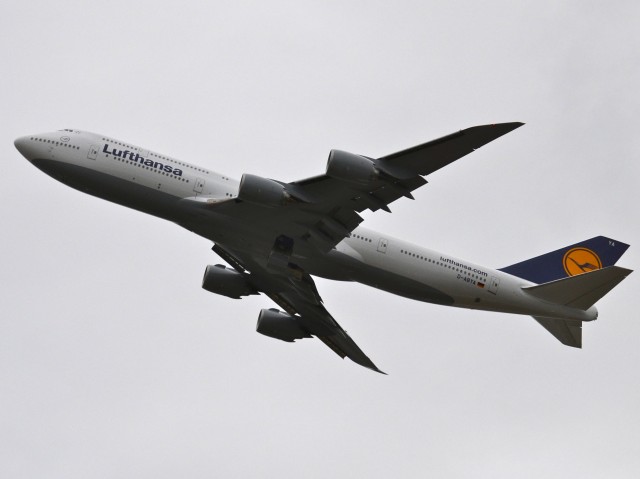
Lufthansa's first Boeing 747-8 Intercontinental shortly after take off from Paine Field. Photo by Jon Ostrower.
Jon Ostrower (aka Flight Blogger) was up at Paine Field yesterday when Lufthansa’s first Boeing 747-8 Intercontinental (D-ABYA) had her flight flight.
The first Boeing 747-8I is schedule to be delivered to an unknown VIP customer sometime soon and Lufthansa hopes to take delivery of its Intercontinental sometime in March.
CHECK OUT THE REST OF JON’S PHOTOS
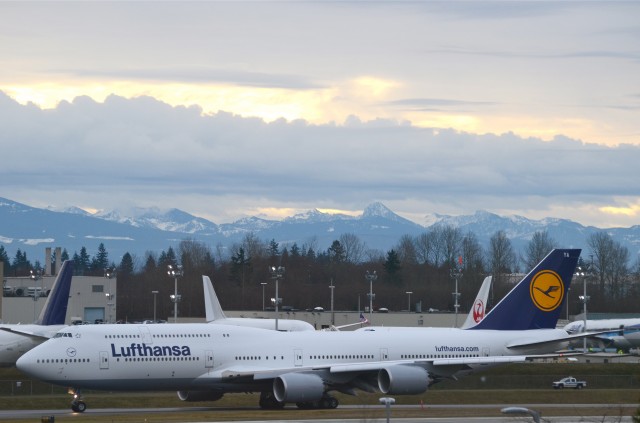
How can you not love Paine Field?
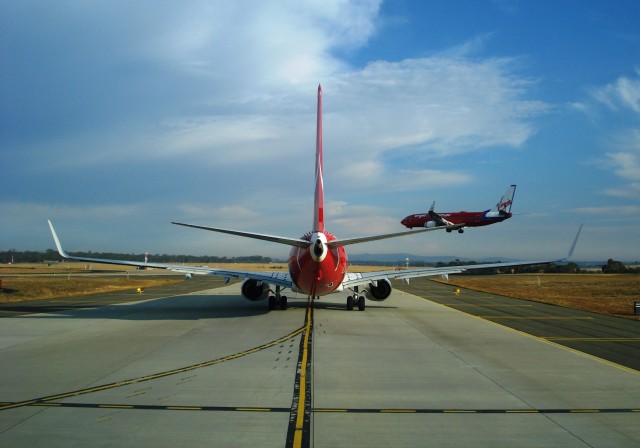
A QANTAS 737-800 awaits take-off clearance as Virgin 737NG lands. Photo by Owen Zupp.
Owen Zupp is a published author, journalist and experienced commercial pilot. With over 16,000 hours of varied flight experience he has flown many creatures, great and small, from outback Australia to all points across the globe. He holds a Masters Degree in Aviation Management and in 2007 his first book, Down to Earth, was published, tracing the combat experiences of a WWII RAF pilot from Dunkirk to D-Day and beyond. He also writes a blog on aviation on his website. This is a two-part story, written by Zupp, talking about his experience flying the Boeing 737 classic versus the 737 NextGeneration. Here is his story in his own words…
Introduction:
Somewhere across the globe a Boeing 737 takes off or lands every 5 seconds and over 1200 of their compatriots are aloft at any given time. With the 7000th aircraft rolled out in December 2011, the 737 has truly brought the term ’˜prolific’ to airliner production and considering the maiden flight of the 737-100 took place in 1967, it is quite appropriate that the latest metamorphism be dubbed the ’œNext Generation’.
With its title clipped to the more easily handled, ’œNG’, the ’˜next generation’ covers the -600 through to the -900 series of the 737. Of Boeing’s latest offering the 700 and larger 800s have gone on to dominate the skies, while the ’˜Max’ is still yet to come. The NGs predecessors, the -200, -300 and -400 had provided the backbone of short haul travel in a very similar way. Whilst the number of earlier models is ever dwindling, they have gone on to be referred to as ’˜The Classics’ as they reflect a last bridge between the analogue and digital flight deck. Whilst a highly visible transition, the clocks and dials are but one area of many in which the Classic has been superseded.
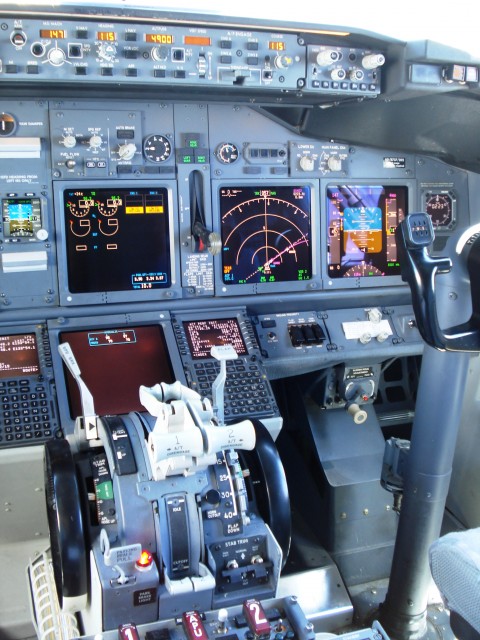
The flight deck of a Boeing 737-800. Photo by Owen Zupp.
737 Next Generation Development:
The 737NG program was launched in 1993 under the title of 737-X. Boeing recognized the time-tested qualities of the type, but needed to bring the efficiency of new technology and systems to its most enduring machine. Fundamentally, the 737-X was to fly higher, farther, faster and more fuel efficiently than its predecessor without evolving into a new machine requiring a new designator and certification. A challenging task to say the least.
Much of the efficiency revolved around the redesigned wing. With 25% more total surface area and potentially 30% more fuel capacity, the new wing has much to offer. Boasting a higher span than the Classic, the new wing is a more swept with a constant angle of sweep and double-slotted continuous span flaps. Gone is the double swept leading edge and characteristic ’˜kink’ of the earlier wing. Similarly, there have been changes to the leading and trailing edge flaps that have resulted in weight saving as well as aerodynamic efficiency. For all of the improvements to the aerofoil and lift augmentation devices, the most visible change to the wing and the aircraft generally, is the emergence of blended winglets on the 737.
The smooth, upward sweeping fairings at the tips stand a prodigious 2.4 metres and increase the span by a metre and a half. Simply put, the winglets benefit the aircraft through the reduction of induced drag and consequently improved operational and economic performance. Whilst yielding an impressive 4% saving in mission block fuel, the winglets also increase the 800s range by over 100nm. (Source: Boeing) Improved performance out of ’˜hot, high and humid’ airfields is another advantage of the blended winglet. In fact, this aerodynamic device has proved so successful that it is now being retrofitted to 757s as well as 737s.
The NG also sees the introduction of GPS to the 737 navigation system. Previously only equipped with dual Inertial Reference Systems (IRSs), the system relied upon ’˜updates’ from ground based VORs and DMEs to continually refine the aircraft’s present position. Without such updates, the pictorial presentation on the map display could be inaccurate requiring the crew to heavily rely on ’˜raw data’ from conventional radio navigation aids. GPS provides a far more consistently accurate map display for the crew and allows for more integration of the aircraft’s Lateral Navigation (LNAV) and Vertical Navigation (VNAV) systems. Additionally, the NG is equipped with a Predictive Windshear Warning and Enhanced Ground Proximity Warning System (EGPWS). This ’˜forward-looking’ form of the original GPWS provides improved terrain clearance by such mechanisms as Terrain Clearance Floor, Look Ahead and Runway Clearance Floor algorythms.
Efficiency and costs savings can also be achieved on the ground. Production line improvements saw the final assembly of a 737NG in a record-breaking 11 days in 2005. On the maintenance side, the NG was developed with an eye to reducing airframe maintenance costs by 15%. Comprised of significantly less parts than the Classic, the NG was also designed with far more ’˜ease of access’ for maintenance crews. Redesigned leading edges, landing gear, electronics, APU and the 15% more efficient CFM56-7 engines all contributed to the bottom line. In conjunction with improved maintenance documents, corrosion prevention and extended scheduled maintenance intervals, the 737NG has won the battle of the dollar over its forerunner.
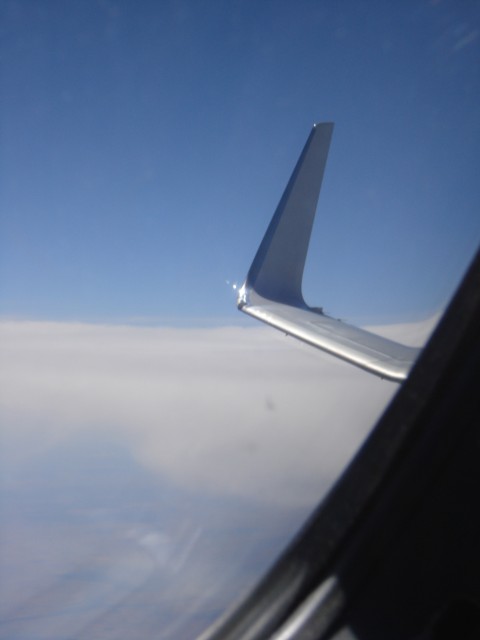
Looking back at the blended winglet of the 737NG. Photo by Owen Zupp.
On the flight deck, the 737NG strongly resembles its twin-engined big brother, the Boeing 777. The panel is dominated by the presence of 6 LCD panels arranged side by side, replacing the combination of EFIS and analogue that was found on the Classic. For the pilots, this means a degree of modification of their instrument scan from the vertical to the horizontal. The flight deck was designed in response to the demand by operators that a new type endorsement not be needed. As a consequence, the overhead panel closely resembles the Classic with its array of toggle switches and dials, though the operation of the system behind the switch may well be different.
As for achieving higher, faster, farther and more fuel efficient performance; Boeing delivered. The NG possesses greater range by more than 400nm over the earlier model, whilst topping out at FL410 (41,000 feet) as opposed to the Classic ceiling of FL370 (37,000 feet). With a typical cruise speed of 0.78M and a sprint capability to 0.82M, the NG draws away from the Classic’s average cruise of 0.745M, whilst all the while burning less fuel. Furthermore, depending on the cabin configuration, the -800 can achieve all of this while carrying around 40 more passengers than its predecessor. From humble beginnings as the 737-100 nearly 40 years ago, the 737 has kept pace with the times through ongoing development and improvement. The 737NG is no exception.
Technologically, some 737 NGs can be equipped with a ’˜Head-Up Guidance System’ or ’˜HGS’. The HGS 4000 system features a transparent drop-down screen in front of the Captain on which is projected an array of flight information, allowing the pilot to operate in lower visibility situations than would otherwise be possible. Head-Up Display (HUD) technology has been available for years on military aircraft and Alaska Airlines started flying HUD on their 727s back in the mid-80s and all of their 737-400s are equipped with the technology.
Some airlines have opted for the Vertical Situation Display (VSD) on their aircraft. The VSD displays the current and predicted flight path of the aircraft and indicates potential conflicts with terrain. The VSD is designed to enhance situational awareness on the flight deck and is yet another way in which the Next Generation is offering advances over its predecessor.
BOEING 737 CLASSIC vs NEXT GENERATION
Part 1 | Part 2 | Owen’s Blog
Do you own an older Boeing 747 and are looking to improve the way it looks? Does your upper deck just look so small compared to the 747-300, 747-400 and especially the 747-8I? Well, do not worry… Boeing has a deal for you: the 747 Stretched Upper Deck (SUD). Well, I guess Boeing had a deal for you, since they aren’t in the business of doing this anymore.
The SUD gave airlines operating older -100 and -200 747 models, the ability to stretch the upper deck and increase the number of passengers flown. When plane spotting, it is typically easy to tell the difference from a 747-100/200 and the 747-300 by check out the stretched upper deck, but the SUD makes it a bit more complicated.
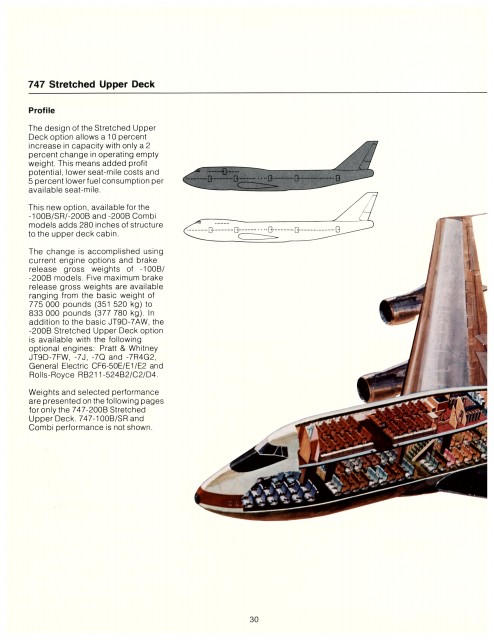
CLICK FOR LARGER: Information for airlines on the Boeing 747 Stretched Upper Deck. Image from Boeing.
From the image above: “The design of the Stretched Upper Deck option allows a 10 percent increase in capacity with only a 2 percent change in operating empty weight. This means added profit potential, lower seat-mile costs and 5 percent lower fuel consumption per available seat-mile.”
“This new option, available for the -100B/SR/-200B and -200B Combi models adds 280 inches of structure to the upper deck cabin.”
“The change is accomplished using current engine options and brake release gross weights of -100B/-200B models. Five maximum brake release gross weights are available ranging from the basic weight of 775,000 pounds (351 520 kg) to 833,000 pounds (377 780 kg). In addition to the basic JT9D-7AW, the -200B Stretched Upper Deck option is available with the following optional engines: Pratt & Whitney JT9D-JFW, -7J, -7Q and -7R4G2, General Electric CF6-50E/E1/E2 and Rolls-Royce RB211-524B2/C2/D4.”
“Weights and selected performance are presented on the following pages for only the 747-200B Stretched Upper Deck. 747-100B/SR and Combi performance is not shown.”
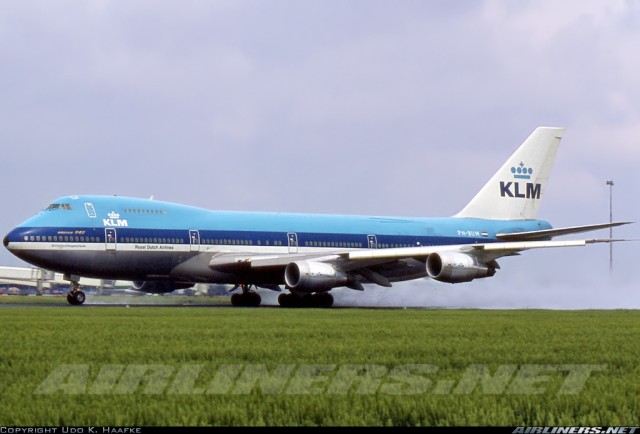
KLM Boeing 747-200 (PH-BUM) tkaen in May 1980 before the SUD upgrade. Photo by Udo Haafke.
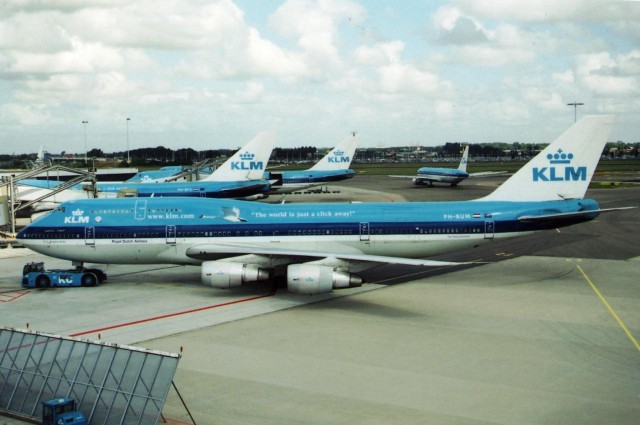
The same KLM Boeing 747-200 (PH-BUM) now with a Stretched Upper Deck. It looks like a Boeing 747-300, but really is still a -200. Taken in August 2003. Photo by Savvas Garozis.
Images by Udo K Haafke and Savvas Garozis
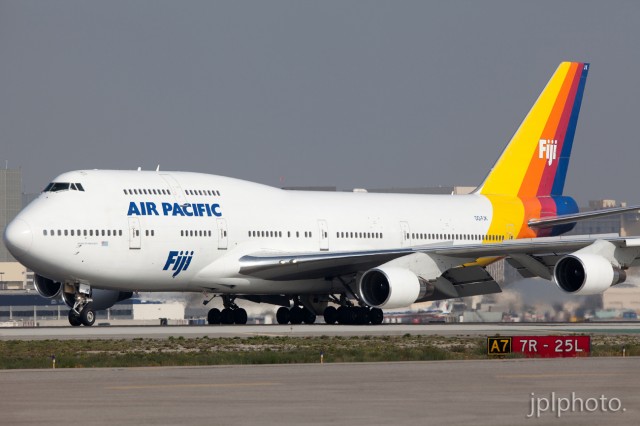
Air Pacific Boeing 747-400 seen at Los Angeles (LAX).
Air Pacific was founded in 1947 and is the flag carrier of Fiji. Currently the airline is 51% owned by the Fijian government and a little over 46% owned by Qantas Airlines.
The airline operates a fleet of only six aircraft consisting of 2 Boeing 747-400s, and four Boeing 737s. They have orders for three Airbus A330s that they hope to put into service in March 2013 to replace their aging 747s. The A330s will be the airline’s first time purchasing brand new aircraft. Previously, Air Pacific had an order for eight Boeing 787s, but all eight were cancelled in April of 2011.
I know there are many folks who do not like liveries with a white fuselage, but I think the tail more than makes up for the white. Although the livery does look good on the Boeing 737, I think it is really at home on the 747.
Image: Jeremy Dwyer-Lindgren
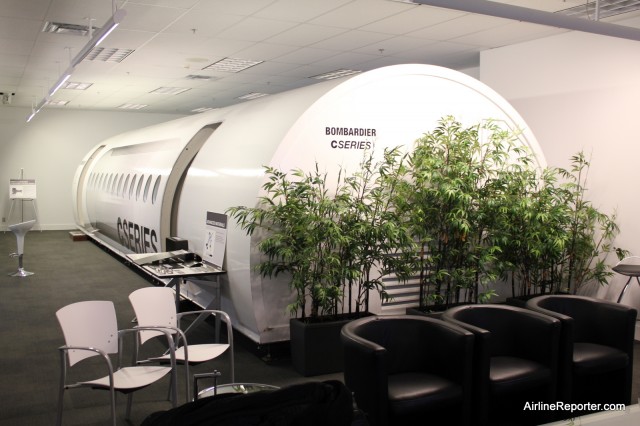
Bombardier's Cseries located in Montreal, Quebec -- tres bon!
After spending the day with Bombardier recently to learn about their new CSeries, the biggest thing I pulled away that you, the passenger will care the most about is SPACE — lots of it. This is the interior that many passengers have been begging for and they are finally going to get it. All the time , I hear people asking for wider seats, more room, etc. But really, what airline is going to take a Boeing 737 or Airbus A320 and go from six seats across to five? (hint: none). The CSeries is designed to provide that extra space that passengers want, but not the additional weight that costs the airlines more money. Bombardier has built enough width into their new CSeries to give passengers extra room, but not enough for airlines to fit in additional seats.
The cabin of the CSeries is set up in a 2-3 layout for economy and 2-2 layout for first class. Personally, I have always loved this layout on the DC-9/MD-80/Boeing 717 aircraft. If you are flying with someone, it gives you the chance for you two to sit together on the two side and not be bothered by a third person. A big downside of those older aircraft was the noise level in the back of the plane from the engines being rear mounted. That won’t be a problem with the CSeries, since the engines are wing-mounted.
Some readers on my Facebook pointed out that having a wider seat is not something new. Piedmont Airlines did it, but it surely has been a long while and really this comes from the design of the aircraft, not from an airline deciding to make the middle seat wider.
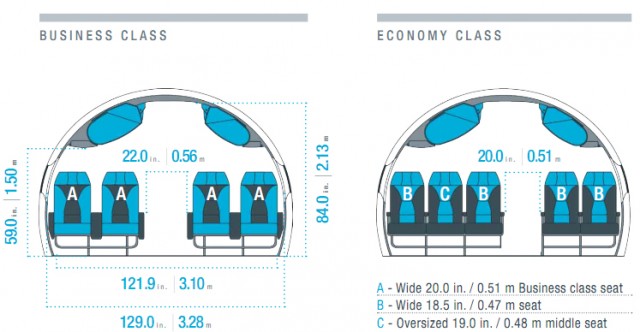
There is plenty of width in the new Bombardier CSeries. Image from Bombardier.
The interior is designed so that most economy seats have 18.5″ width — except the middle seat which is 19″. Now, this just blew my mind… the middle seat is actually 1/2″ wider than the other seats on the plane. How genius is that? Not only that, but a standard 18.5″ width for a short haul seat is great. Many airlines run wide-body, long haul flights with only 18″ or even 17″.
Now, I know what you are all thinking, “Yea right. Bombardier might design the aircraft with space, but airlines will find ways to use that space to fit in as many seats as possible.” Well, do not worry, that will not be the case. First off, there is about half a seat width (from an average aircraft) of extra space built into the plane. If you do the math and an airline puts the aisle to 18″, that would mean each seat would be 15.8″ and that just is not going to happen. Plus, the plane is designed to hold so many passengers with the emergency exits given, so even if an airline made impossibly thin seats, most of them would have to remain empty.
Although seat width will be pretty standard, airlines will have choice with what seat pitch they want to offer. The CSeries mock up in Montreal has the rows set up with different examples from 32″ to 28″. Let me say that at 6’1″, I really hope no airline opts for the 28″ seat pitch on any airplane — ever.
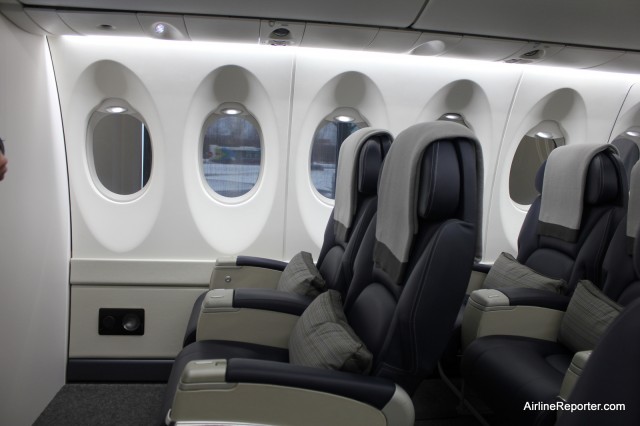
The windows are quite large on the new CSeries, providing more natural light and shoulder room.
The CSeries will sport larger windows than its competition, allowing more natural light and a bit more shoulder room. The CSeries will have windows measuring 11×16″, which are about the size you would find on a Boeing 777.
If you choose a window seat, rest assured, you will actually get a window. How annoying is it to get to your window seat and see a solid wall with no window? Bombardier designed the CSeries so that each row would have at least one window. Not only does this provide great spotting opportunities, it also allows more natural light into the cabin.
At this point, it appears that each window will have a traditional sun shade and not the electronic ones found on the 787 Dreamliner. The reason is this is a smaller aircraft, running shorter hops than the 787 and the extra cost really did not make sense. Like the Dreamliner, the CSeries will also have LED lighting that can change color based on what the airline customer might want.
The aircraft is set to compete directly with the Airbus A318 and A319, the Boeing 737-600 / 737-700, and the Embraer E-195. Bombardier is also hoping those airlines that operate DC-9s and MD-80 aircraft (I am talking to you American and Delta Air Lines) might want to update their fleet with the CSeries.
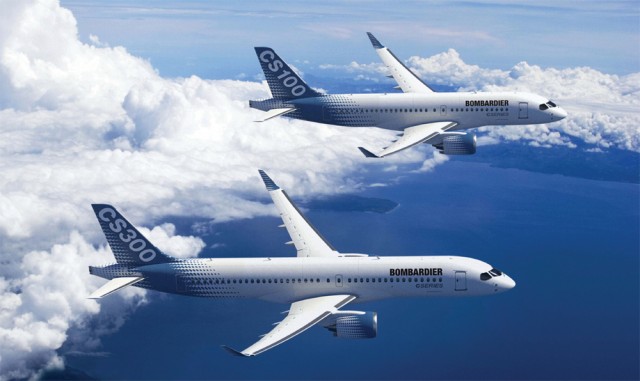
A look at the CSeries 100 and CSeries 300 in this computer mock up from Bombardier.
When designing the CSeries, Bombardier decided to use an aluminum alloy for the fuselage and composite wings. “For the fuselage we performed trade-off analyses, involving airlines in the process, between composite and advanced aluminum design options,” Sebastien Mullot, CSeries Program Director at Bombardier, explained to AirlineReporter.com. “It turned out that the weight gain in the composite option was not as important as in other composite parts (e.g wing) and airlines drew our attention to the fact that this weight gain might be offset by the additional costs that could be incurred on the maintenance side.”
Since the CSeries will be a high-cycle aircraft, there is a much higher chance that the aircraft will be damaged during normal operations. Currently, repairing composite aircraft requires special equipment and procedures, which would have increased operational costs and complexity for airlines. The aluminum alloy used on the CSeries is a aluminum-lithium hybrid that is lighter than traditional aluminum and still can be repaired easily. For now, it seemed to be a perfect fit for what the CSeries will be doing.
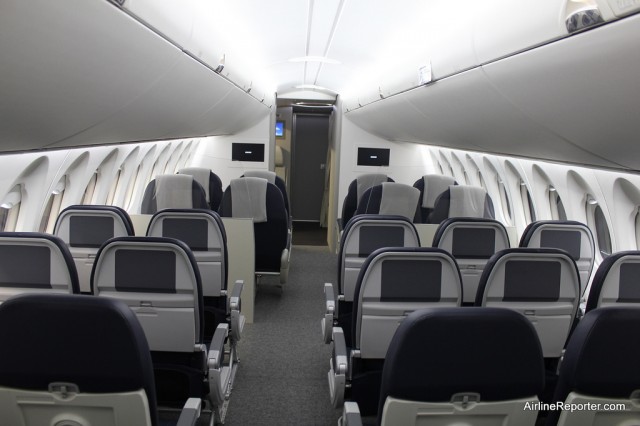
The mock up for the CSeries has different seat pitches for each row. You can see that some have fake entertainment screens as well.
Bombardier is confident that the CSeries will have its first flight before the end of the year. When I asked about potential delays, they stated that they had built-in time for potential delays and unlike other aircraft manufacturers, they have been outsourcing part of their aircraft production for a very long time and are well experienced. They have already been able to work out the kinks and problems from experiences learned with previous aircraft and have not seen the issues that other companies have (ie Boeing and Airbus).
The company hopes that the CSeries will be a complete package for airlines, passengers, crew and the environment. “In an challenging economic environment, airlines have been seeking to grow their average aircraft size in a race to improve their cost efficiency,” Mullot explained. “This aircraft will also be the only single-aisle aircraft to meet 21st century operating requirements: improving flight crew situational awareness, meeting new air traffic control needs and dramatically reducing airlines’ environmental footprint!”
One interesting fact is that we do not know who the launch customer for the CSeries will be. That customer has asked to remain secret and Bombardier is not talking. I am hoping it will be a game changer like Southwest, Ryanair or EasyJet who all operate single aircraft type, but it likely will not be that exciting.
OTHER CSERIES STUFF YOU MUST CHECK OUT:
* All 17 photos of the CSeries mockup in Montreal
* Video of the second mock up by Simpliflying













